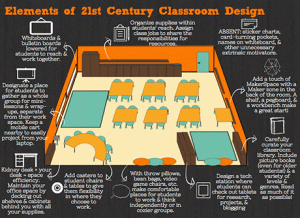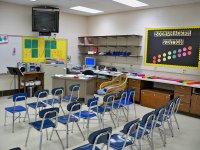Visualizing 21st-Century Classroom Design
These five steps are essential in creating a 21st-century classroom: establishing zones, ensuring resource accessibility, encouraging mobility, igniting inspiration, and fostering respect.
Problem-based learning, makerspaces, flipped learning, student blogging -- these are becoming perceived staples of 21st-century learning. With such ambitious practices taking the spotlight for how people regard modern classrooms, it's not surprising that a murmur of impracticality or skepticism is still a frequent response when they're first introduced.
So how do we encourage teachers everywhere to believe that great changes can happen in their classrooms? By helping them envision small, practical steps that will lead them there. Here are five elements of 21st-century classrooms, along with concrete suggestions that teachers can visualize and implement today.
Element #1: Zones
21st-Century Learning Principle
Instead of requiring students to learn, work, and think in one place all day, consider how your space might become more flexible.
Practical Steps
- Designate a whole-group special gathering zone (class meetings, wrap-ups, mini-lessons) by laying a second-hand rug or taping down a perimeter -- even for older students!
- Maximize space by having your desk do double-duty with the kidney desk, but maintain office space with shelves on the wall behind you.
- Get creative with the student workspace zone by providing spaces for working as individuals, pairs, and groups.
- Request donations for beanbags and oversized pillows, and check thrift shops.
- Add casters to chairs, and top individual desks with plywood for flexible group tables.
- Arrange furniture to create nooks.

Element #2: Accessibility
21st-Century Learning Principle
To walk the talk of a real classroom community, we must ask ourselves if all of our resources are designed and arranged for the convenience of all learners.
Practical Steps
- Ask your students for feedback on how they use and would like to use classroom resources.
- Ask your administration's permission to have the custodian adjust the height of bulletin boards, whiteboards, hooks, and anything else that isn't as functional as it could be.
Element #3: Mobility
21st-Century Learning Principle
We need to be sure that we're not catering to just one type of learner. Be mindful of your introverts, extroverts, collaborators, solo thinkers, writers, dreamers, and fidgeters -- and design a flexible environment that can meet everyone's needs.
Practical Steps
Create a tech station to allow students more choices in how to research, practice, and present learning. Don't have 1:1 or even 30:1? Start today by submitting a DonorsChoose project requesting a tablet or laptop. Chromebooks are under $200 and iPad Minis under $300. Then, immediately install an arsenal of apps or Chrome apps to help preclude the all-too-common "what do I do with these devices?" dilemma.
Blogging apps:
Math practice apps:
Research help apps:
Publishing/creating apps:
Fun fast-finisher apps:
Classroom organization apps:
Examine low-tech options:
The abovementioned casters will help your students easily roll their chairs away if they need to work solo for a bit, or to collaborate with multiple people around the classroom. Add a clipboard, and voila -- a budget-friendly version of the Node chair.
Element #4: Inspiration
21st-Century Learning Principle
We often expect students to passively wait until we present opportunities to create, and then we expect them to turn on that creativity like a faucet. We should find ways to foster ongoing inspiration and creativity.
Practical Steps
- Set aside a creation/inspiration zone that's open to students as often as possible (Genius Bar, Wonder Shelf, makerspace, etc.)
- Explicitly teach and emphasize process over product, growth mindset, and metacognition. We cannot cultivate risk taking, failing, and perseverance -- all essential characteristics of creativity -- if we repeatedly demonstrate to students how all that really matters is neatly filling out our worksheets.
Element #5: Respect
21st-Century Learning Principle
Consider our students who don't do school very well. You know the ones -- the kid who rarely earns stars and class bucks, the kid who never brings homework, the kid whose name is called far more frequently than others (but usually for remonstration). For them, traditional school quickly becomes a game of "me vs. the teacher." For their sake, we must find ways to dissolve this mindset, replacing it with the real reason why we're all at school -- genuine learning and growth.
Practical Steps
- Carefully examine your reward systems and ask yourself: "Do they perpetuate or lessen the perceived game of student vs. teacher?" Take steps to minimize extrinsic rewards that often do nothing but reinforce to struggling students the futility of their efforts.
- Focus on your one-on-one relationship with each student. Greet them at the door, ask them about their interests, and listen.
- Fiercely safeguard time for end-of-lesson wrap-ups and reflections. Those moments are the perfect opportunity to highlight the conversation of ownership. After all, this is about student learning. Model and let them learn from others how individuals make learning personal and genuinely apply it to their lives.
What small changes can you visualize in your room today? Comment below to share your practical strategies.
